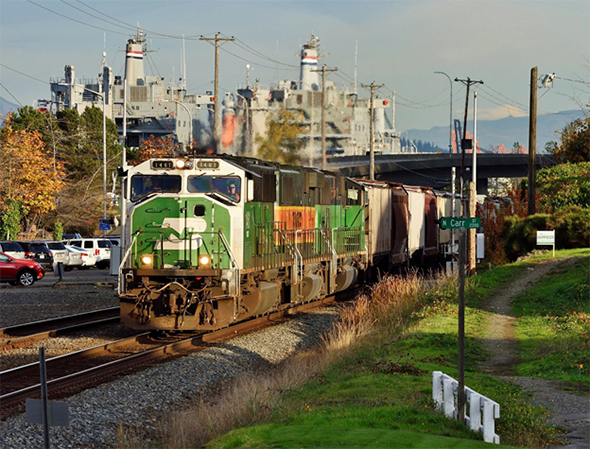
The Department of Homeland Security announced a regulatory review with public input that will address potential changes to how the agency handles dangerous goods and other safety issues, with a focus on both rail transport and port security as two of the main objectives. A BNSF freight train passes the Port of Tacoma, Washington on October 22nd, 2016. Image © 10/2016 by Nikki Burgess; all rights reserved.
Happy Monday, all! Are your Halloween preps nearly finished? Only a week to go! Speaking of weeks; last week’s DG Digest gave pride of place to our brand new edition of the Dangerous Goods Report, so, this week, we’ll take a look at what the last two weeks of activity have brought to the forefront of regulations. Let’s jump right in:
FMCSA
- FMCSA amends its commercial driver’s license (CDL) regulations to ease the transition of military personnel into civilian careers driving commercial motor vehicles (CMVs) by simplifying the process of obtaining a commercial learner’s permit (CLP) or CDL. This final rule extends the period of time for applying for a skills test waiver from 90 days to 1 year after leaving a military position requiring the operation of a CMV. This final rule also allows a State to accept applications from active duty military personnel who are stationed in that State as well as administer the written and skills tests for a CLP or CDL. Here’s the good news for our veterans
- FMCSA adopted as final certain regulations required by the Fixing America’s Surface Transportation Act (FAST Act) enacted on December 4, 2015. The rules involve statutory changes that went into effect on October 1, 2016, and require that FMCSA make conforming changes to its regulations to ensure they are current and consistent with the statutory requirements. Some of these changes deal with FMCSA’s Safety Data System. See the details here
- FMCSA requests approval to renew the ICR titled ‘‘Training Certification for Drivers of Longer Combination Vehicles (LCVs).’’ This ICR relates to Agency requirements for drivers to be certified to operate LCVs, and that motor carriers must satisfy before permitting their drivers to operate LCVs. Motor carriers, upon inquiry by authorized Federal, State or local officials, must produce an LCV driver-training certificate for each of their LCV drivers. Comments must be received on or before December 13, 2016. Here’s the link
PHMSA
- The U.S. Department of Transportation’s (DOT) Pipeline and Hazardous Materials Safety Administration (PHMSA) issued a guidance memorandum clarifying the agency’s final rule from June 2, 2016, which removed the packing group (PG) II designation for Organic Peroxides, and Self-Reactive Substances in the Hazardous Materials Table (HMT). See the guidance
- PHMSA will conduct a public meeting on Tuesday, November 15, 2016, in preparation for the 50th session of the United Nations Sub-Committee of Experts on the Transport of Dangerous Goods to be held in Geneva, Switzerland from November 28 to December 6, 2016. PHMSA will be requesting comments relative to potential new work items that may be considered for inclusion in the international agenda. Interested? Here’s your way in
- PHMSA released a Letter of Interpretation on September 29th which has provided some very interesting and relevant guidance regarding the use of reduced size labels and markings on packages which may lack the space to apply a set of complete full sized such labels and markings
FAA
- The FAA issued this notice to advise the public of a meeting of Fifth RTCA SC–235 Non Rechargeable Lithium Batteries Plenary Session. The meeting will be held November 15–16, 2016 from 09:00 a.m.–05:00 p.m. in Washington, DC. Here’s the invite
- In news it’s likely you’ve already heard, the FAA imposed a blanket ban on any carriage aboard aircraft for the Samsung Galaxy Note 7. The now somewhat infamous devices are suspected as the cause of several incidents in airports or aboard aircraft that resulted in fires that may be associated with the lithium battery powers sources that the devices use. At the same time, the previous safety order regarding the units was withdrawn to allow the emergency order to take effect. Here are links to the two actions: Emergency Order (blanket ban); Withdrawal of the Safety Order
DHS
- The Department of Homeland Security announced that it will accept public comment in reference to a regulatory review it intends to conduct covering numerous current security measures, including several relating to Dangerous Goods. Chemical facility safety standards and railroad chemical transport security are among the top issues to be reviewed. See the details here
- TSA has issued an ICR in reference to information required for submission by enrollees in its Transportation Worker Identification Card, or TWIC, program. TSA will use the information collected to conduct a security threat assessment, which includes: (1) A criminal history records check; (2) a check of intelligence databases; and (3) an immigration status check. TSA may also use the information to determine a TWIC holder’s eligibility to participate in TSA’s expedited screening program for air travel, TSA Pre✓®. TSA invites all TWIC® applicants to complete an optional survey to gather information on the applicants’ overall customer satisfaction with the enrollment process. Here is the portal to participate
AVIATION SAFETY
Alaska Airlines was forced to do extensive testing of passenger baggage after an undeclared shipment of fish preserved in the chemical formaldehyde leaked in flight recently. Although no safety of flight issue occurred and no one was injured, the chemical is a known carcinogen and the resulting mess caused extensive delay and inconvenience. More proof that carriers will have to pay extra attention to what passengers may unwittingly introduce aboard their aircraft. See the details here
OSHA
- OSHA has recently updated the Guidelines for Safety and Health Programs it first released 30 years ago, to reflect changes in the economy, workplaces, and evolving safety and health issues. The new Recommended Practices have been well received by a wide variety of stakeholders and are designed to be used in a wide variety of small and medium-sized business settings. The Recommended Practices present a step-by-step approach to implementing a safety and health program, built around seven core elements that make up a successful program
- OSHA has agreed to further delay enforcement of the anti-retaliation provisions in its new workplace injury and illness tracking rule until Dec. 1, 2016. The U.S. District Court for the Northern District of Texas requested the delay to allow additional time to consider a motion challenging the new provisions. See the story here
- OSHA released its annual list of the ten most cited violations in its safety enforcement programs. As usual, things like fall protection, hazard communication, and machine guarding were prominent players. See the full list and OSHA’s take on the situation here
- In an ancillary to OSHA activity, the Labor Department released an ICR requiring a report of the census of fatal occupational injuries. This data is used by DOL and OSHA to determine enforcement and mitigation foci moving forward into the New Year. See the ICR here
EPA
The agency has reopened the comment period in reference to the hazard communication portions of the “significant new use” provisions of the revised Toxic Substances Control Act (TSCA). Still have a comment to make on this important revision? Here’s the portal
Labelmaster is a full service provider of products and services for the Hazardous Materials and Dangerous Goods professional, shippers, transport operators, and EH&S providers. See our full line of solutions at www.labelmaster.com.


